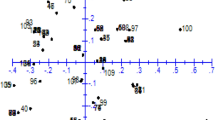Summary
Isozyme variation was studied in 1,417 cultivars and wild forms of taro collected in Asia and Oceania. Seven polymorphic enzyme systems (MDH, IDH, PGI, 6-PGD, ME, SkDH, and ADH) revealed 143 isozyme phenotypes, or zymotypes, each uniquely characterized by the presence or absence of 56 electromorphs. Results showed greater isozyme variation in Asia than in Oceania, with Indonesia being the area of greatest diversity. No correlations were found between zymotypes and morphotypes or ploidy levels (as described by other investigators). Multivariate analyses of the isozyme data indicated that the majority of the Indonesian cultivars were different from the Philippine and Oceanian taro cultivars. Oceanian cultivars constituted a continuum of clusters and are thought to have originated from a narrow genetic base introduced from Indonesia. If taro breeding is to have any future in Oceania, it is important to exchange genotypes to broaden the base of existing breeding programmes.
Similar content being viewed by others
References
Barrau J., 1965. Histoire et préhistoire horticoles de l'Océanie tropicale. J. Soc. Oc. 21: 55–78.
Bousquet J., W.M. Cheliak & M. Lalonde, 1987. Allozyme variation in natural populations of green alder (Alnus crispa) in Quebec. Genome 29: 345–352.
Brown W.H., 1920. Wild Food Plants of the Philippines. Bulletin No. 21, Department of Agriculture and Natural Resources, Manila.
Coates D.J., D.E. Yen & P.M. Gaffey, 1988. Chromosome Variation in Taro, Colocasia esculenta: Implications for origin in the Pacific. Cytologia 53: 551–560.
Guarino, L. & G.V.H. Jackson, 1986. Describing and Documenting Root Crops in the South Pacific. UNDP/FAO, RAS/83/001 Field Document no. 12. Suva, Fiji.
Hambali, G.G., 1980. The dispersal of taro by common palm civets. IFS Prov. Dept. No. 5: 29–34.
Hirai M., T. Sato & K. Takayanagi, 1989. Classification of Japanese Cultivars of Taro (Colocasia esculenta (L.) Schott) Based on Electrophoretic Pattern of the Tuber Proteins and Morphological Characters. Japan. J. Breed. 39: 307–317.
Jackson, G.V.H., 1978. Alomae and Bobone Diseases of Taro. South Pacific Commission Advisory Leaflet 8: 5 pp., Noumea, New Caledonia.
Jackson, G.V.H. & J. Breen, 1985. Collecting, Describing and Evaluating Root Crops. UNDP/FAO, RAS/83/001 Field Document no. 8. Suva, Fiji.
Kuruvilla K.M. & A. Singh, 1981. Karyotypic and Electrophoretic Studies on Taro and its Origin. Euphytica 30: 405–413.
Lebot V., K.M. Aradhya & R.M. Manshardt, 1991. Geographical Survey of Genetic Variation in Kava (Piper methysticum Forst. f. and P. wichmannii C. DC.). Pacific Science 45(2): 169–187.
Plucknett D.L., 1976. Edible Aroids: Alocasia, Colocasia, Cyrtosperma, Xanthosoma. In: N.W. Simmonds (Ed.), Evolution of Crop Plants. London and New York: Longman, pp. 10–12.
Purseglove J.W., 1972. Tropical Crops. Monocotyledons. London and New York: Longman. pp. 62–69.
Tanimoto T. & T. Matsumoto, 1986. Variations of Morphological Characters and Isozyme Patterns in Japanese Cultivars of Colocasia esculenta Schott and C. gigantea Hook. Japan. J. Breed. 36: 100–111.
Tanimoto T., 1990. Distribution and Morphological Characteristics of Wild Taro (Colocasia esculenta Schott.) in Japan and Taiwan. Japan. J. Breed. 40: 233–243.
Whitney, L.D., F.A.I. Bowers & M. Takahashi, 1939. Taro Varieties in Hawaii. Bulletin No. 84 of The Hawaii Agricultural Experiment Station, University of Hawaii, Honolulu.
Wilson J.E., 1981. Effects of formulation and method of applying gibberellic acid on flower promotion in cocoyam. Expl. Agric. 17: 317–322.
Wilson, J.E., 1990. Agro-Facts: Taro Breeding. University of the South Pacific, IRETA Publication No. 3/89. 51 pp.
Yen D.E. & J.M. Wheeler, 1968. Introduction of taro into the Pacific: the indications of chromosome numbers. Ethnology 7: 259–267.
Author information
Authors and Affiliations
Rights and permissions
About this article
Cite this article
Lebot, V., Aradhya, K.M. Isozyme variation in taro (Colocasia esculenta (L.) Schott) from Asia and Oceania. Euphytica 56, 55–66 (1991). https://doi.org/10.1007/BF00041744
Received:
Accepted:
Issue Date:
DOI: https://doi.org/10.1007/BF00041744




